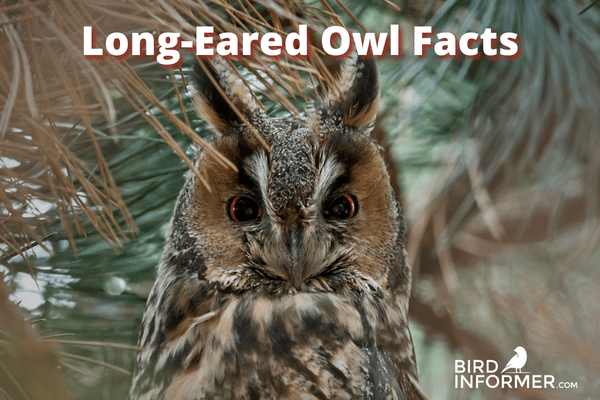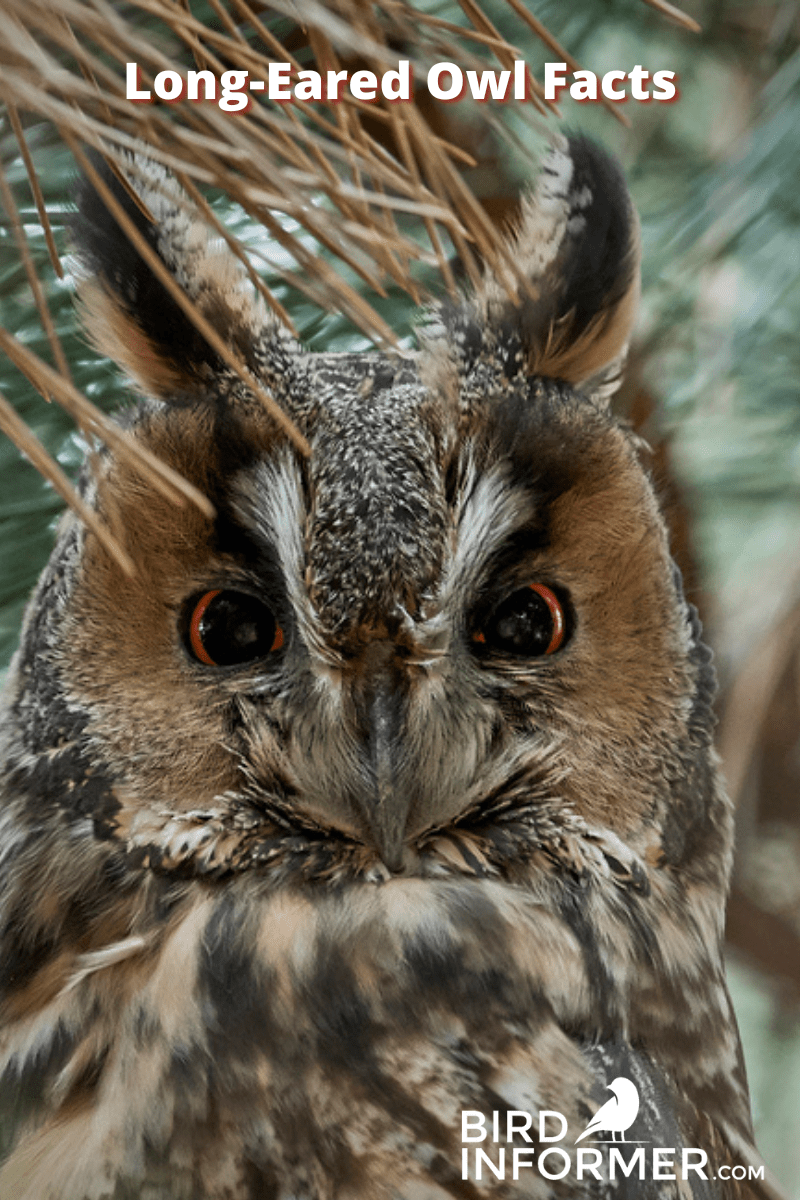Contents [show]
The long-eared owl, otherwise known as the cat owl or lesser horned owl, is a species of medium-size. As an owl species, it is considered one particular species with an extensive breeding range.
From a scientific standpoint, the actual name of this bird species is A. otus and it’s a member of the Strigidae family. You’ll find this species of owl throughout a wide range of breeding areas. But more specifically, you can find this owl in North America, the Palaearctic, and Europe.
Besides the wonderful facts that I already shared with you today, I’d also like to tell you about many other important long-eared owl-related topics. So, I will take a deep dive into the following areas regarding that include:
- The easiest way to identify a long-eared owl
- Long-eared owl fun and interesting facts
- Long-eared owl physical differences between females and males
- Behavioral, migratory, feeding, and nesting habits of the long-eared owl
- Even more crucial facts
Discover all of this and more about the long-eared owl below.
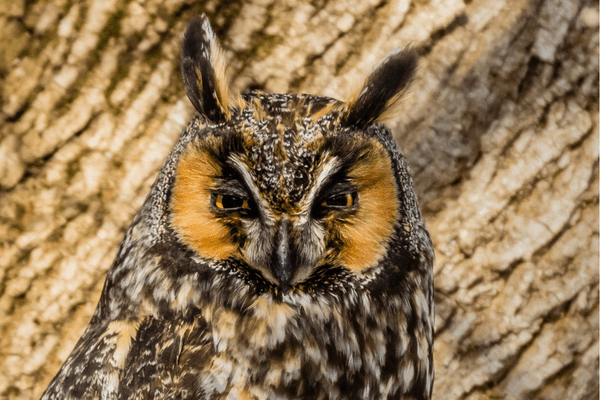
Long-eared owl facts
- Common Name: Long-Eared Owl
- Scientific Name: Asio otus
- Scientific Family: Strigidae
- Life Span: 10-30 years
- Size: 14.0 to 16.0 inches
- Wingspan: 35.4 to 39.4 inches
- Weight: 7.8 to 15.3 oz
- Conservation status: Least Concern
Long-eared owl: how-to identify
It’s pretty easy to identify a long-eared owl. Their feathers are fairly dark. And they have large ear tufts that are very similar to the great-horned owl. They are black tufts with orange or buff fringes. They also have buff or orange faces with very intricate dark brown or black patterns on the feathers.
Their faces are made up of two vertical white lines that go directly between their eyes. And speaking of eyes, they have beautiful yellow eyes that glow brightly in the dark.
Differences Between Male & Female
The common difference between male and female long-eared owls is relatively common amongst all owls. On average, the females are the larger members of the species.
Females can weigh between 6.3-15.3 ounces. Males, on the other hand, usually weigh between 5.6-11.6 ounces. Females also have larger wingspans and they are generally longer creatures than their male counterparts as well.
Differences In Summer Plumage vs Winter Plumage
There don’t appear to be any major differences between summer and winter plumage for long-eared owls.
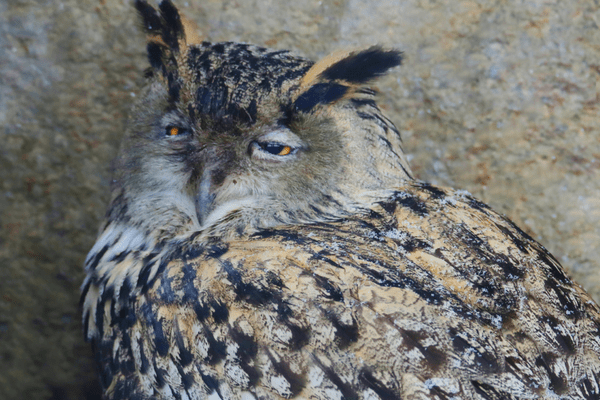
Where You’ll See Long-Eared Owls
It’s important to note that long-eared owls are found in Mexico, the United States, Europe, and parts of Asia. They are even found in remote parts of the world including the Azores, the Canary Islands, North Africa, and East Africa.
More commonly, you’ll discover long-eared owls in the Western states during all seasons. But they are also located in the northeast in the New England area all season long.
Long-eared owl bird migration
Typically, you’ll find long-eared owls in Mexico, the southeastern portion of the United States, and other areas during the winter. They will withdraw from the northern parts of their breeding range during this time. Why? They are looking for warmer and sunnier climates.
Long-eared owl diet
Mainly, long-eared owls prefer to eat small mammals. They specifically stick to voles and mice. But when food is scarce during a particularly tough winter, they will resort to eating small birds as well.
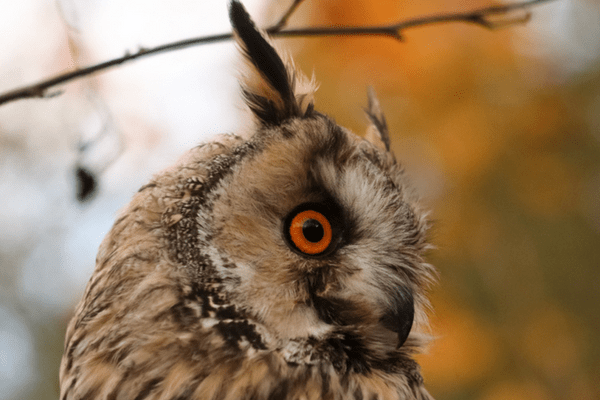
Long-eared owl nesting
- Clutch Size: 2-10 eggs
- # of Broods: 1 brood
- Incubation Period: 25-30 days
- Nestling period: 45-70 days
- Egg Description: White
For the most part, long-eared owls will nest in trees. It’s important to note that these creatures like to nest in man-made nesting boxes or those constructed by different species. On occasion, this owl will build a nest on its own, but it doesn’t happen too often.
After the nest is selected, the female will begin laying her eggs. She will lay as many as 2 up to 10 eggs. This usually happens in two-day intervals.
Long-eared owl behavior
Long-eared owls are nocturnal creatures so they definitely prefer hunting at night most of the time. You will occasionally find them active at or before dusk, and this is especially true when it’s time to feed their young.
While hunting, the long-eared owl is known for flying low to the ground. This makes it easy to locate prey via sight and sound. They will swoop down, grab their prey with sharp talons, and then fly away to a safe spot so they can eat their prey whole.
These beautiful owl creatures are well camouflaged and secretive as well. If you’re having a difficult time finding them in your backyard at night, you should spend time outside in the summer or spring and listen for low and long hoots.
Believe it or not, it’s easier to spot long-eared owls in the wintertime. They tend to roost together in much larger numbers. They likely huddled together to stay warm. But even so, this makes it much easier to spot them because there are more of them in larger groups while roosting together.
Lastly, and I’ve already alluded to this already, the long-eared owl is very social, which is weird for owls in general. They specifically like to roost together in groups, and this happens more often during the winter, but they will even roost together in the spring and summer.
The majority of their groups are made up of as many as 20 individual long-eared owls. Although, when there are lots of available covers, you could find as many as 100 large long-eared owls roosting together in the same place.
How-to attract long-eared owls
Long-eared owls are more than willing to live in man-made structures inside of your backyard. Generally speaking, you can put it in a nesting box, wicker basket, or some other man-made structure and the long-eared owl would have no problem taking it over. In fact, we know this because they usually do not build their own nests, but instead, take over the nest created by other animals.
Besides adding nesting boxes to your backyard, it’s always important to leave the grass relatively long and the branches of trees unpruned. They like to have hidden places to perch so they can easily catch prey in your backyard.
Keep the grass long because this will be more attractive to small prey and other animals including insects, voles, mice, rodents, squirrels, and other small creatures. Remember, the long-eared owl was hunting prey and eating its prey whole, which means you have to create the proper environment you can call home.
Adding a water source to your backyard is always a great way to attract many long-eared owls. These animals will certainly appreciate having a large birdbath or fountain in the backyard that they can use to keep themselves clean and hydrated. They’ll also use this water to hydrate their young, and their partners. And they will use this water to help keep everyone clean, refreshed, and healthy.
It’s also important to install the nesting box in the right place. The best area is to have it facing away from the wind. Put it in a south-facing direction that will make it easy for the owls to remain warm from the direct sunshine. And most important of all, make sure the nesting box is stable and secure in the tree. If it moves subtly, by wind or other factors, the owls may not use it because they won’t feel protected from other owls, the wind, or various predators.
Long-eared owl threats
Currently, the long-eared owl is determined to have a conservation status of Least Concern. Although there are plenty of long-eared owls in existence and they aren’t ready to become endangered, their population is currently decreasing. This decrease in population is happening because of land clearing, construction, and other reasons for the loss of habitat.
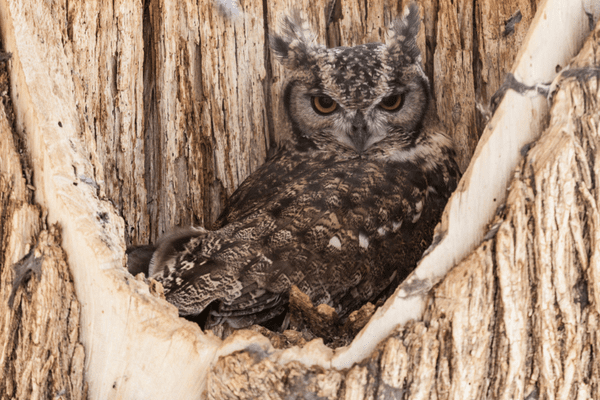
Long-eared owl fun & interesting facts
- The male owl has a very loud hoot. At times, it can be heard up to 0.7 miles, or 1 km away.
- These creatures are known for their precision hunting and silent flight. They have feathers that have downy surfaces and fringed edges, which make them the perfect silent assassins because they have a really muted sound while flying through the air.
- These owls also have incredible hearing. Their ear openings are placed asymmetrically, plus they have sound-catching facial discs that are very large, which makes it easy for these owls to hear sounds from miles away.
- When a Long-eared owl catches its prey, it will swallow the entire thing as a whole. Later, it will regurgitate the indigestible parts in the form of pellets. It usually regurgitates these pellets once per day. It’s fascinating to pick through regurgitated long-eared owl pellets because they contain all kinds of fur, small animal bones, and other interesting things.
- Long-eared owls are prominently populated throughout Eurasia and North America. You can also find them in isolated groups throughout east and north Africa, the Canary Islands, and the Azores. We know a great deal about long-eared owls in Europe and the United States, but we know very little about the ones in other parts of the world.
- It is well documented that long-eared owls will appropriate nests from other species of birds or other creatures. In one instance, researchers discovered and documented long-eared owls appropriating nests that were previously constructed by American Crows very recently.
- Short-Eared Owl
- Western Screech-Owl
- Northern Hawk Owl
- Eastern Screech-Owl
- Flammulated Owl
- Great Grey Owl
- Northern Pygmy-Owl
- Spotted Owl
- Elf Owl
- Burrowing Owl
- Barred Owl
- Snowy Owl
- Boreal Owl
- Northern Saw-Whet Owl

